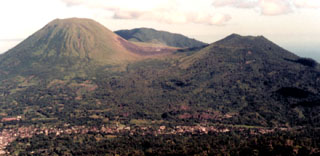Report on Lokon-Empung (Indonesia) — November 1986
Scientific Event Alert Network Bulletin, vol. 11, no. 11 (November 1986)
Managing Editor: Lindsay McClelland.
Lokon-Empung (Indonesia) Frequent explosions; ashfall to the SE
Please cite this report as:
Global Volcanism Program, 1986. Report on Lokon-Empung (Indonesia) (McClelland, L., ed.). Scientific Event Alert Network Bulletin, 11:11. Smithsonian Institution. https://doi.org/10.5479/si.GVP.SEAN198611-266100
Lokon-Empung
Indonesia
1.3644°N, 124.7992°E; summit elev. 1580 m
All times are local (unless otherwise noted)
Approximately 100 explosions occurred at Tompaluan Crater in November, with ~20 recorded 21-27 November, and 33 the previous week. The strongest, on 22 November at 1921, ejected lava fragments and incandescent bombs that fell within 400 m of the crater in the S summit area. An ash column rose 1,000 m and ashfall occurred over a wide area to the SE. Less than 0.5 mm of ash fell at the Kakaskasen Volcano Observatory, ~5.5 km SE of the crater. No casualties or crop damages were reported. The Observatory recorded 37 volcanic earthquakes during November.
Geological Summary. The Lokong-Empung volcanic complex, rising above the plain of Tondano in North Sulawesi, includes four peaks and an active crater. Lokon, the highest peak, has a flat craterless top. The morphologically younger Empung cone 2 km NE has a 400-m-wide, 150-m-deep crater that erupted last in the 18th century. A ridge extending 3 km WNW from Lokon includes the Tatawiran and Tetempangan peaks. All eruptions since 1829 have originated from Tompaluan, a 150 x 250 m crater in the saddle between Lokon and Empung. These eruptions have primarily produced small-to-moderate ash plumes that sometimes damaged croplands and houses, but lava-dome growth and pyroclastic flows have also occurred.
Information Contacts: VSI; ANS.

